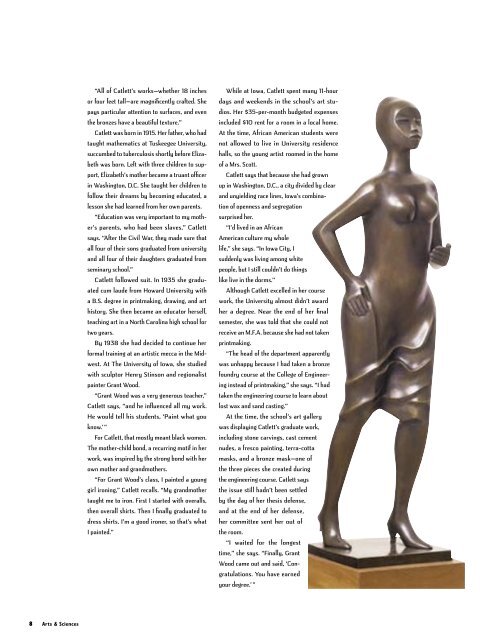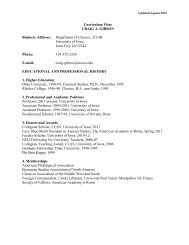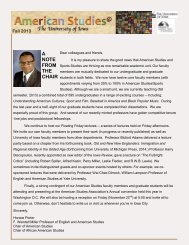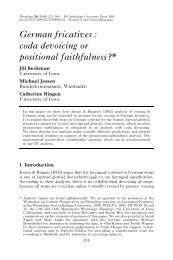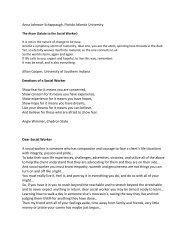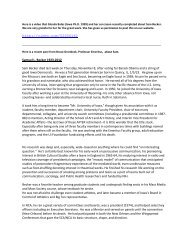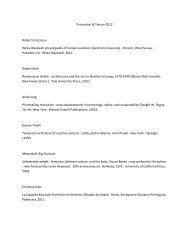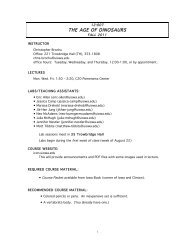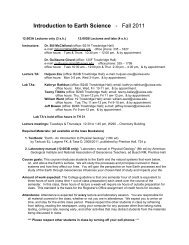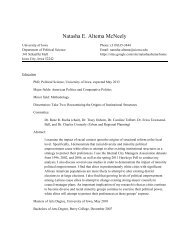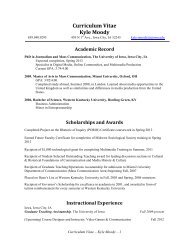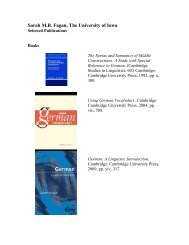By Jean C. Florman - College of Liberal Arts & Sciences - The ...
By Jean C. Florman - College of Liberal Arts & Sciences - The ...
By Jean C. Florman - College of Liberal Arts & Sciences - The ...
Create successful ePaper yourself
Turn your PDF publications into a flip-book with our unique Google optimized e-Paper software.
8 <strong>Arts</strong> & <strong>Sciences</strong><br />
“All <strong>of</strong> Catlett’s works—whether 18 inches<br />
or four feet tall—are magnificently crafted. She<br />
pays particular attention to surfaces, and even<br />
the bronzes have a beautiful texture.”<br />
Catlett was born in 1915. Her father, who had<br />
taught mathematics at Tuskeegee University,<br />
succumbed to tuberculosis shortly before Elizabeth<br />
was born. Left with three children to support,<br />
Elizabeth’s mother became a truant <strong>of</strong>ficer<br />
in Washington, D.C. She taught her children to<br />
follow their dreams by becoming educated, a<br />
lesson she had learned from her own parents.<br />
“Education was very important to my mother’s<br />
parents, who had been slaves,” Catlett<br />
says. “After the Civil War, they made sure that<br />
all four <strong>of</strong> their sons graduated from university<br />
and all four <strong>of</strong> their daughters graduated from<br />
seminary school.”<br />
Catlett followed suit. In 1935 she graduated<br />
cum laude from Howard University with<br />
a B.S. degree in printmaking, drawing, and art<br />
history. She then became an educator herself,<br />
teaching art in a North Carolina high school for<br />
two years.<br />
<strong>By</strong> 1938 she had decided to continue her<br />
formal training at an artistic mecca in the Midwest.<br />
At <strong>The</strong> University <strong>of</strong> Iowa, she studied<br />
with sculptor Henry Stinson and regionalist<br />
painter Grant Wood.<br />
“Grant Wood was a very generous teacher,”<br />
Catlett says, “and he influenced all my work.<br />
He would tell his students, ‘Paint what you<br />
know.’ ”<br />
For Catlett, that mostly meant black women.<br />
<strong>The</strong> mother-child bond, a recurring motif in her<br />
work, was inspired by the strong bond with her<br />
own mother and grandmothers.<br />
“For Grant Wood’s class, I painted a young<br />
girl ironing,” Catlett recalls. “My grandmother<br />
taught me to iron. First I started with overalls,<br />
then overall shirts. <strong>The</strong>n I finally graduated to<br />
dress shirts. I’m a good ironer, so that’s what<br />
I painted.”<br />
While at Iowa, Catlett spent many 11-hour<br />
days and weekends in the school’s art studios.<br />
Her $35-per-month budgeted expenses<br />
included $10 rent for a room in a local home.<br />
At the time, African American students were<br />
not allowed to live in University residence<br />
halls, so the young artist roomed in the home<br />
<strong>of</strong> a Mrs. Scott.<br />
Catlett says that because she had grown<br />
up in Washington, D.C., a city divided by clear<br />
and unyielding race lines, Iowa’s combination<br />
<strong>of</strong> openness and segregation<br />
surprised her.<br />
“I’d lived in an African<br />
American culture my whole<br />
life,” she says. “In Iowa City, I<br />
suddenly was living among white<br />
people, but I still couldn’t do things<br />
like live in the dorms.”<br />
Although Catlett excelled in her course<br />
work, the University almost didn’t award<br />
her a degree. Near the end <strong>of</strong> her final<br />
semester, she was told that she could not<br />
receive an M.F.A. because she had not taken<br />
printmaking.<br />
“<strong>The</strong> head <strong>of</strong> the department apparently<br />
was unhappy because I had taken a bronze<br />
foundry course at the <strong>College</strong> <strong>of</strong> Engineering<br />
instead <strong>of</strong> printmaking,” she says. “I had<br />
taken the engineering course to learn about<br />
lost wax and sand casting.”<br />
At the time, the school’s art gallery<br />
was displaying Catlett’s graduate work,<br />
including stone carvings, cast cement<br />
nudes, a fresco painting, terra-cotta<br />
masks, and a bronze mask—one <strong>of</strong><br />
the three pieces she created during<br />
the engineering course. Catlett says<br />
the issue still hadn’t been settled<br />
by the day <strong>of</strong> her thesis defense,<br />
and at the end <strong>of</strong> her defense,<br />
her committee sent her out <strong>of</strong><br />
the room.<br />
“I waited for the longest<br />
time,” she says. “Finally, Grant<br />
Wood came out and said, ‘Congratulations.<br />
You have earned<br />
your degree.’ ”


